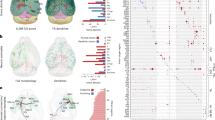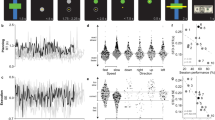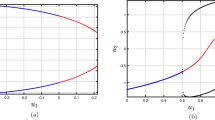Abstract
MECHANICAL stimulation of the body surface of the leech causes a localized withdrawal from dorsal, ventral and lateral stimuli. The pathways from sensory to motor neurons in the reflex include at least one interneuron1. We have identified a subset of inter-neurons contributing to the reflex by intracellular recording, and our analysis of interneuron input and output connections suggests a network in which most interneurons respond to more than one sensory input, most have effects on all motor neurons and in which each form of the behaviour is produced by appropriate and inap-propriate effects of many interneurons. To determine whether interneurons of this type can account for the behaviour, or whether additional types are required, model networks were trained by back-propagation2 to reproduce the physiologically determined input-output function of the reflex. Quantitative comparisons of model and actual connection strengths show that model inter-neurons are similar to real ones. Consequently, the identified subset of interneurons could control local bending as part of a distributed processing network in which each form of the behaviour is produced by the appropriate and inappropriate effects of many interneurons.
This is a preview of subscription content, access via your institution
Access options
Subscribe to this journal
Receive 51 print issues and online access
$199.00 per year
only $3.90 per issue
Buy this article
- Purchase on SpringerLink
- Instant access to full article PDF
Prices may be subject to local taxes which are calculated during checkout
Similar content being viewed by others
References
Kristan, W. B. Jr. J. exp. Biol. 96, 161–180 (1982).
Rumelhart, D. E., Hinton, G. E. & Williams, R. J. Nature 323, 533–536 (1986).
Nicholls, J. G. & Baylor, D. A. J. Neurophysiol. 31, 740–756 (1968).
Stuart, A. E. J. Physiol., Lond. 209, 627–646 (1970).
Ort, C. A., Kristan, W. B., Jr. & Stent, G. S. J. comp. Physiol. 94, 121–154 (1974).
Lehky, S. R. & Sejnowski, T. J. Nature 333, 452–454 (1988).
Zipser, D. & Andersen, R. A. Nature 331, 679–684 (1988).
Anastasio, T. & Robinson, D. A. Neural Comp. 1, 230–241 (1989).
Pineda, F. J. Phys. Rev. Lett. 59, 2229–2232 (1987).
Williams, R. J. & Zipser, D. Neural Comp. (in the press).
Granzow, B., Friesen, W. O. & Kristan, W. B., Jr. J. Neurosci. 5, 2035–2050 (1985).
Nusbaum, M. P., Friesen, W. O., Kristan, W. B., Jr. & Pierce, R. A. J. cōmp. Physiol. A161, 355–366 (1987).
Author information
Authors and Affiliations
Rights and permissions
About this article
Cite this article
Lockery, S., Wittenberg, G., Kristan, W. et al. Function of identified interneurons in the leech elucidated using neural networks trained by back-propagation. Nature 340, 468–471 (1989). https://doi.org/10.1038/340468a0
Received:
Accepted:
Issue date:
DOI: https://doi.org/10.1038/340468a0
This article is cited by
-
Effects of Touch Location and Intensity on Interneurons of the Leech Local Bend Network
Scientific Reports (2018)
-
A neuronal network for computing population vectors in the leech
Nature (1998)
-
Evolutionary epistemology as an overlapping, interlevel theory
Biology & Philosophy (1993)
-
Vestibuloocular reflex arc analysis using an experimentally constrained neural network
Biological Cybernetics (1992)
-
Two forms of sensitization of the local bending reflex of the medicinal leech
Journal of Comparative Physiology A (1991)



